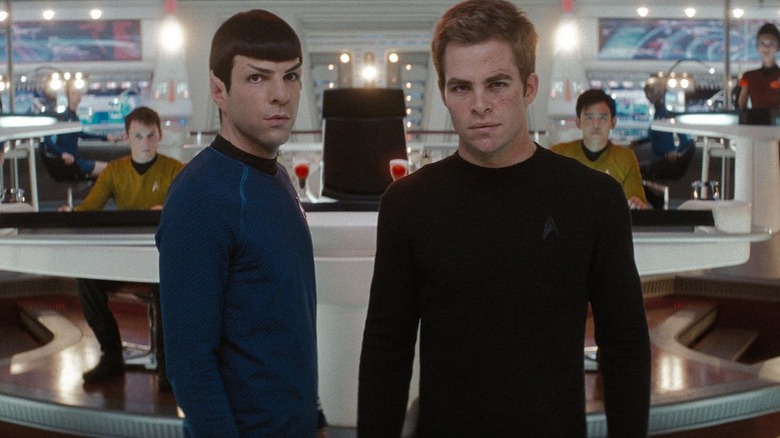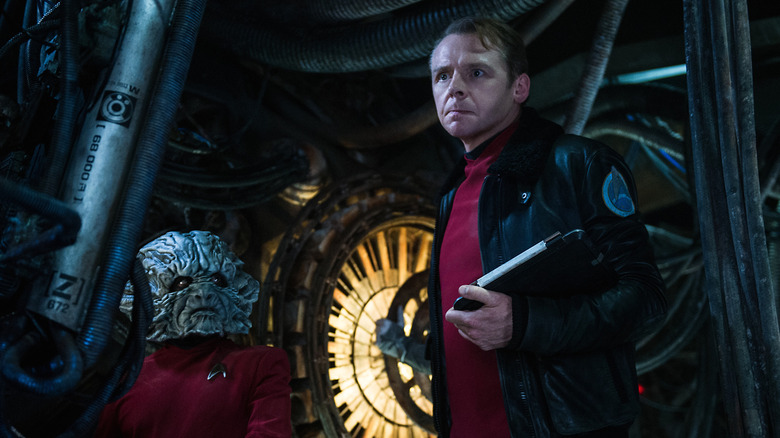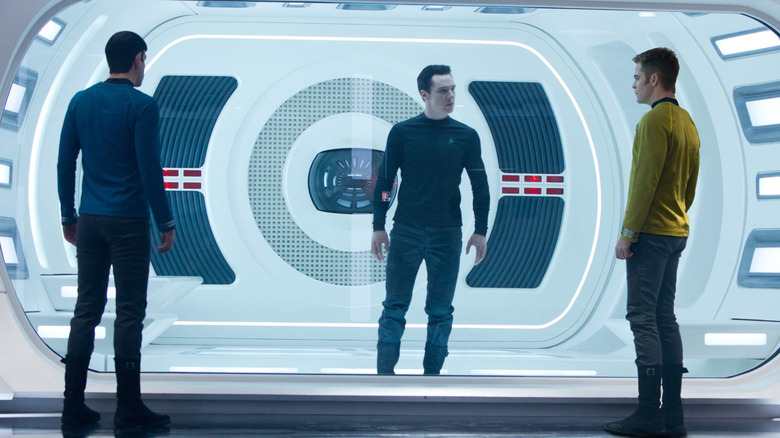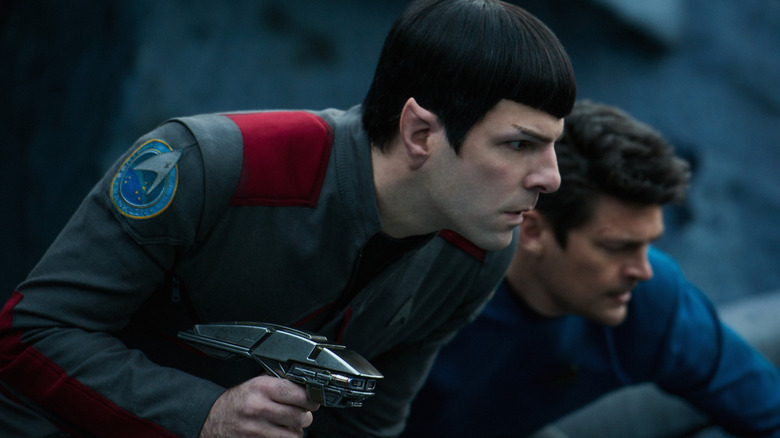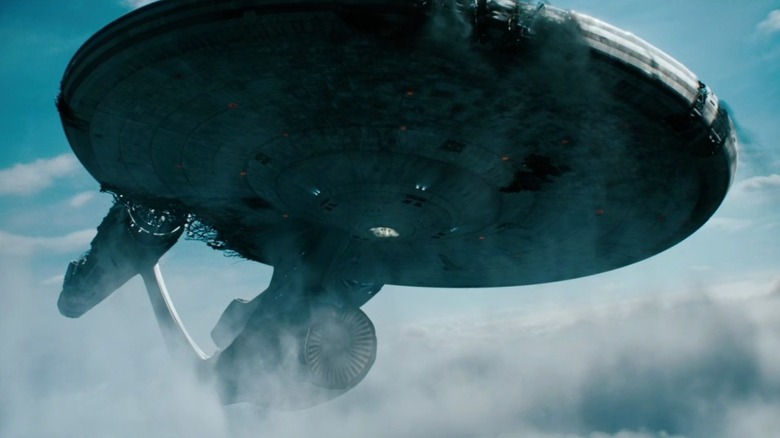5 Reasons Why Star Trek's Kelvin Timeline Failed
We may receive a commission on purchases made from links.
After years of discussion, it's finally time to say goodbye to the Kelvin timeline, "Star Trek" fans. Granted, it's been almost a decade since we've seen Chris Pine's Captain Kirk on the big screen dating back to 2016's "Star Trek Beyond," but Paramount has made it official: It's moving on.
It was only just reported that Paramount, which has merged with Skydance and is now under new leadership, is working on a new "Star Trek" movie, but it won't involve the Kelvin cast. That ensemble first emerged in the 2009 "Star Trek" reboot film directed by J.J. Abrams, which gave the franchise new life in the broader cultural sphere. But after "Beyond," things got messy, uncertain, and now, this ride is over.
There has been talk of another entry in the Kelvin timeline dating back to 2016, at which point it was first revealed that Chris Hemsworth might return as George Kirk in a version of "Star Trek 4" that was later scrapped. Ever since then, there have been endless discussions, creative shifts, and other distractions that derailed any hope of a continuation. Now, it's simply a thing that could have been rather than a thing that will be.
So, what went wrong, exactly? Why did the Kelvin timeline ultimately fail? We're going to look at some of the biggest reasons why "Star Trek 4" fell apart and why this iteration of the legendary sci-fi franchise is part of its past, rather than its future. Let's get into it.
The movies got too expensive
"Star Trek" has been a staple of pop culture dating back to the '60s when the original series aired on TV for the first time. Rather crucially, though, this is a franchise that traces its roots to the small screen and not as a series of feature films. "Star Trek: The Motion Picture" proved that there was an appetite for such movies, but at a certain price point. Generally speaking, the "Star Trek" films have thrived as mid-budget plays. When they get too expensive, things get dicey.
That's precisely what happened with the Kelvin timeline, pretty much from the jump. 2009's "Star Trek" made $386.8 million at the global box office against a $140 million budget. It was a good-but-not-great result for a movie that expensive. But it gave Paramount the sense that this franchise could be bigger, and that's precisely what happened. "Star Trek Into Darkness" made $467.3 million worldwide, which remains a record for the property, but it also cost almost $190 million before marketing. Meanwhile, "Beyond" made just $335.6 million globally on a $185 million budget, which made it a major disappointment.
By contrast, movies like the much-beloved "Star Trek: First Contact" were far cheaper to make. In this case, we're looking at a $45 million movie that grossed $150 million worldwide. That's the sweet spot for these movies, historically speaking, but Paramount's eyes got big, and J.J. Abrams doesn't tend to work cheap. In the end, the prospect of making "Star Trek 4" with an expensive, A-list cast stopped making sense on paper, particularly as the box office remains on wildly uncertain ground in the pandemic era.
For Kelvin to continue, it needed to scale down, and that didn't seem plausible with all of the pieces on the board.
Star Trek was thriving on the small screen
"Star Trek Beyond" was liked well enough, but it came out in 2016 and, the following year, Paramount decided to double down on "Star Trek" on TV, taking it back to its roots while keeping one eye on the future. Beginning in 2017 on CBS All Access (before it became Paramount+), "Star Trek: Discovery" started its five-season run. Whether or not every Trekkie loved it is another conversation entirely, but the fans were engaging with the show. It was also just the tip of the iceberg.
This kicked the door open for a new era of "Trek" on TV for the streaming era. Patrick Stewart would also return for "Picard," which enjoyed a three-season run. "Picard" season 3 was also a major "Next Generation" reunion, which was huge for the fanbase. Meanwhile, other fans could also enjoy animated shows like "Lower Decks," and even kids had "Prodigy."
Then came "Star Trek: Strange New Worlds," which remains downright cherished by the fandom. It's three seasons in with more on the way. Without picking each show apart, there is a lot of variety here and a little something for every sort of Trekkie. "Star Trek" has been straight-up thriving on TV in recent years.
It's only become harder to get people to head to movie theaters of late because streaming has become the go-to delivery system for entertainment. Thus, a "Star Trek" movie became increasingly difficult to sell as these shows continued to thrive. "We have 'Star Trek' at home" is one way to look at it. Paramount, in its pursuit of getting skin in the game in the streaming wars, kneecapped its case to make another Kelvin timeline film.
No clear consensus on creative direction
Paramount first started discussing a fourth Kelvin "Star Trek" movie in 2016 before "Beyond" even hit theaters. That version, as mentioned, would have involved Chris Hemsworth returning as Kirk's dad. It never came together and, ever since, it's been an up-and-down rollercoaster of new writers, directors, ideas, and other movies, making it clear there was no consensus at the studio when it came to creative direction.
Noah Hawley ("Fargo") was at one point going to make a version of "Star Trek 4," but that fell apart. That goes double for the version that was almost helmed by Matt Shakman ("The Fantastic Four: First Steps"). Creatives came and went with the cast providing little updates along the way, but nothing ever materialized. But these creative issues aren't limited to this specific sequel. Other ventures have muddied the waters over the years as well.
Quentin Tarantino famously tried to get an R-rated "Star Trek" movie made. It didn't happen. Several other "Star Trek" films not explicitly related to the Kelvin timeline were put into development as well. It became crystal clear that getting any "Trek" movie across the finish line was going to be difficult, if not downright impossible. The creative back-and-forth behind the scenes undoubtedly helped extinguish any real hope that this iteration of the franchise might actually carry on.
As recently as last year, it looked like the Kelvin "Star Trek" movies might get one last chapter, but those hopes are now dashed. There was no confidence or clarity of direction, and that was evident to anyone who pays attention to the goings on of Hollywood. The Kelvin timeline became mired in the uncertainty surrounding the franchise's future.
Paramount waited too long to make Star Trek 4
If Paramount truly wanted to make "Star Trek 4" and keep the Kelvin timeline alive, it missed the window to do so. Sure, it could have pressed forth by doing so anyway, but that wouldn't have made a great deal of sense. For as complicated as the financials may have been in the aftermath of "Beyond," it feels like a fool's errand to try and do the movie now. In short, the studio truly missed the window of opportunity (at least for now, anyway).
Sequels that happen years after their predecessors often have a big hill to climb, unless we're talking about "Avatar: The Way of Water" (i.e. a film with a feverish, built-in demand). A new "Star Trek" movie, especially an expensive one, would have to earn its audience outside of hardcore Trekkies. That's a key difference. Any momentum maintained by "Beyond" has long since burned out.
Speaking of "Avatar," the Kelvin cast has become far too busy to wrangle in the years since. Zoe Saldana will be making "Avatar" movies until 2031, as it stands, while Pine became an even bigger star thanks to the "Wonder Woman" films. Elsewhere, Zachary Quinto and Simon Pegg have remained quite busy working on TV shows and the "Mission: Impossible" movies, respectively.
It's all good and well that Pine argued "Star Trek 4" should be smaller with the core fans in mind, but when he made that argument in 2024, it was already too little, too late. At this point, Paramount would be better off letting the Kelvin timeline go for another handful of years, perhaps attempting to reunite the cast down the road once the nostalgia cycle catches up with these movies. But until then, the momentum is good and truly gone.
Star Trek isn't Star Wars
This is not about opening up the age-old debate of "Star Trek" vs. "Star Wars." There is, however, no denying that when J.J. Abrams kicked off the Kelvin timeline in 2009, it felt like an attempt to fill the void left behind by "Star Wars," which concluded its prequel trilogy in 2005. It wasn't until 2012 when Disney purchased Lucasfilm that more "Star Wars" became a thing. Somewhat ironically, it was Abrams who was tasked with reviving a galaxy far, far away with "Star Wars: Episode VII — The Force Awakens" in 2015.
To that end, "The Force Awakens" made more than $2 billion at the box office, becoming one of the biggest movies of all time. No "Star Trek" film has made even a fraction of that amount. With "Star Wars" back, that action/adventure sci-fi void wasn't there for "Star Trek" to fill. Abrams took much of the iconography he was playing with in his "Trek" films and put it into "Wars." There was no longer a need for a surrogate. Average moviegoers and global audiences had "Star Wars" again.
Paramount wanted to make "Star Trek" into a bigger thing. It wanted the franchise to become "Star Wars" on some level. While "Star Trek" has a devoted, loyal audience that is massive and reliable, it has never and probably will never be as big as "Star Wars." The Kelvin timeline was structured around the idea that maybe — just maybe — it could be. In the end, that might have doomed it. Leaning into what "Star Trek" is rather than what it could be is what can save the next movies from a similarly disappointing fate.
You can grab the "Star Trek Trilogy: The Kelvin Timeline" on 4K or Blu-ray from Amazon.
